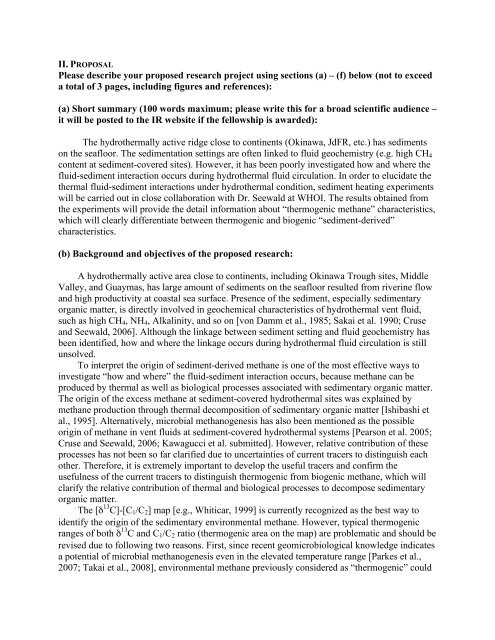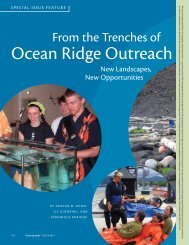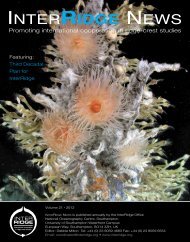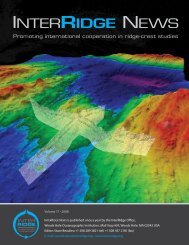Application form InterRidge Student and Postdoctoral Fellowship ...
Application form InterRidge Student and Postdoctoral Fellowship ...
Application form InterRidge Student and Postdoctoral Fellowship ...
- No tags were found...
Create successful ePaper yourself
Turn your PDF publications into a flip-book with our unique Google optimized e-Paper software.
II. PROPOSALPlease describe your proposed research project using sections (a) – (f) below (not to exceeda total of 3 pages, including figures <strong>and</strong> references):(a) Short summary (100 words maximum; please write this for a broad scientific audience –it will be posted to the IR website if the fellowship is awarded):The hydrothermally active ridge close to continents (Okinawa, JdFR, etc.) has sedimentson the seafloor. The sedimentation settings are often linked to fluid geochemistry (e.g. high CH 4content at sediment-covered sites). However, it has been poorly investigated how <strong>and</strong> where thefluid-sediment interaction occurs during hydrothermal fluid circulation. In order to elucidate thethermal fluid-sediment interactions under hydrothermal condition, sediment heating experimentswill be carried out in close collaboration with Dr. Seewald at WHOI. The results obtained fromthe experiments will provide the detail in<strong>form</strong>ation about “thermogenic methane” characteristics,which will clearly differentiate between thermogenic <strong>and</strong> biogenic “sediment-derived”characteristics.(b) Background <strong>and</strong> objectives of the proposed research:A hydrothermally active area close to continents, including Okinawa Trough sites, MiddleValley, <strong>and</strong> Guaymas, has large amount of sediments on the seafloor resulted from riverine flow<strong>and</strong> high productivity at coastal sea surface. Presence of the sediment, especially sedimentaryorganic matter, is directly involved in geochemical characteristics of hydrothermal vent fluid,such as high CH 4 , NH 4 , Alkalinity, <strong>and</strong> so on [von Damm et al., 1985; Sakai et al. 1990; Cruse<strong>and</strong> Seewald, 2006]. Although the linkage between sediment setting <strong>and</strong> fluid geochemistry hasbeen identified, how <strong>and</strong> where the linkage occurs during hydrothermal fluid circulation is stillunsolved.To interpret the origin of sediment-derived methane is one of the most effective ways toinvestigate “how <strong>and</strong> where” the fluid-sediment interaction occurs, because methane can beproduced by thermal as well as biological processes associated with sedimentary organic matter.The origin of the excess methane at sediment-covered hydrothermal sites was explained bymethane production through thermal decomposition of sedimentary organic matter [Ishibashi etal., 1995]. Alternatively, microbial methanogenesis has also been mentioned as the possibleorigin of methane in vent fluids at sediment-covered hydrothermal systems [Pearson et al. 2005;Cruse <strong>and</strong> Seewald, 2006; Kawagucci et al. submitted]. However, relative contribution of theseprocesses has not been so far clarified due to uncertainties of current tracers to distinguish eachother. Therefore, it is extremely important to develop the useful tracers <strong>and</strong> confirm theusefulness of the current tracers to distinguish thermogenic from biogenic methane, which willclarify the relative contribution of thermal <strong>and</strong> biological processes to decompose sedimentaryorganic matter.The [δ 13 C]-[C 1 /C 2 ] map [e.g., Whiticar, 1999] is currently recognized as the best way toidentify the origin of the sedimentary environmental methane. However, typical thermogenicranges of both δ 13 C <strong>and</strong> C 1 /C 2 ratio (thermogenic area on the map) are problematic <strong>and</strong> should berevised due to following two reasons. First, since recent geomicrobiological knowledge indicatesa potential of microbial methanogenesis even in the elevated temperature range [Parkes et al.,2007; Takai et al., 2008], environmental methane previously considered as “thermogenic” could
















